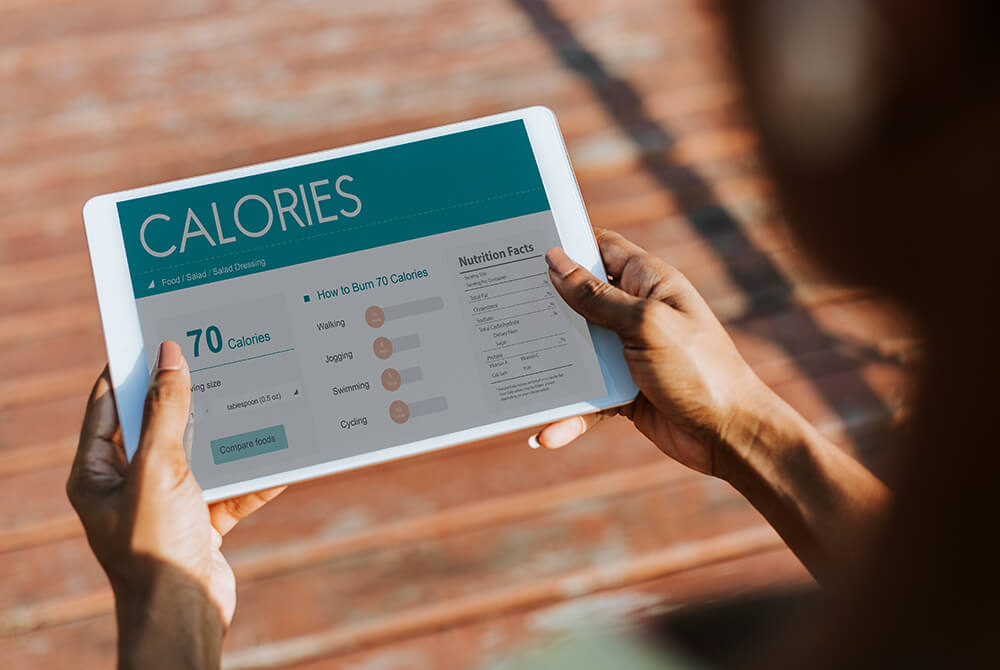The calorie requirement - what is it, what does it depend on, and how do calorie calculators work?

Calorie requirement is the amount of energy you need to provide yourself daily to meet all of your body's energy needs and keep it in good condition. Calorie requirements are influenced by a lot of factors, not just body weight, height and age.
From this article, you will learn what factors account for calorie requirements, what metabolism really is, how calorie calculators work, whether they are always effective and how to calculate calorie requirements without a calculator.
Calorie requirement - what is it?
Calorie requirement is the amount of energy, expressed as kilocalories (kcal), that is required to cover all the body's energy needs during the day. Humans have no other means of supplying themselves with calories except the form of chemical energy from food. The food energy components that participate in meeting calorie requirements are:
- protein - 1 g of protein provides 4 kcal,
- carbohydrates - 1 g of carbohydrates provides 4 kcal,
- fat - 1 g of fat provides 9 kcal,
- ethyl alcohol - 1 g of alcohol provides 7 kcal.
All other nutrients are not included in those that cover a person's calorie requirements. Although, as a result of digestion, sugar alcohols, among others, also provide energy (in an amount that depends on the digestion method), their proportion in the diet of most people is so small that they are often ignored.
Colloquially, it has become common to refer to kilocalories as 'calories', although this is not scientifically correct. Energy requirements and the energy content of food can also be expressed in joules (J) and kilojoules (kJ), but this is much less common.
Energy requirement - definition
According to the official definition created by FAO/WHO/UNU experts, the individual energy requirement for calories is "Energy requirement is the amount of food energy needed to balance energy expenditure in order to maintain body size, body composition and a level of necessary and desirable physical activity consistent with long-term good health. In the case of children as well as pregnant and lactating women, this amount also covers the body's needs for the construction of new tissues and the secretion of milk respectively."
The energy (caloric) requirement consists of the amount of energy consumed by the body in connection with the basal metabolic rate (BMR) and the active metabolic rate (AMR). Together, these give the total metabolic rate (TMR), which is the number of calories consumed by the body in a day.
Calorie requirements and metabolism
How many calories you need per day depends strictly on your metabolic rate or, in other words, metabolism. The calorie requirement, i.e. the number of calories to be consumed each day, is numerically nothing more than the total metabolic rate, which is formed by the processes of:
- basal metabolic rate, which is defined as the lowest level of energy metabolism, occurring in the human body under conditions of complete physical, mental rest, on an empty stomach and in an optimal microclimate. The energy within the BMR is consumed by basic life processes – respiration, blood circulation, heart function, maintaining a constant body temperature, nervous system function, maintaining muscle tone (but not muscle movement), cell production and growth, secretion, e.g. of hormones by glands, excretion, e.g. of sweat through the skin.
- active metabolic rate, which includes all activities associated with daily routines - work, study, physical activity, as well as the energy used by the body to assimilate food (postprandial thermogenesis).
Recommended products to help meet caloric needs
How does calculating calories relate to metabolism?
For most people, calories are simply some numbers. One thing has a lot of calories, the other one has few. Some calories have to be eliminated from meals to lose weight. We rarely think about where these numbers come from and what they mean when calculating calories from meals and energy requirements. We don't focus on the biochemical processes going on constantly in our bodies. However, understanding the subject is worth it.
So often you may hear: "I have a fast metabolism", "I have a slow metabolism". Everyone is different. We do not all use the same amount of energy at the cellular level. The cellular mitochondria, where cellular respiration processes take place, work faster by one person and slower by another. Therefore, some people eat a lot and are always thin, while others control the quantity of their meals and find it difficult to lose weight. So, what is the relationship between the metabolic rate and the calculation of the calories needed each day?
The metabolic rate of the body is the overall rate of cellular oxidation of energy sources by all body organs. Dietary energy sources are carbohydrates, fats, proteins, alcohol and minor dietary components that are oxidised in the cells in the presence of oxygen, which is inhaled through the lungs. Oxygen is taken up by the lungs and transported to the different cells according to their activity and energy needs. More oxygen needs to go to muscle cells than to hair cells. The oxidation of dietary energy sources results in energy to be used by the cells of the body and end products (carbon dioxide, water and urea) that are excreted through the lungs, urine and skin.
The total metabolic rate of the body is assessed by monitoring the rate of oxygen uptake by the lungs. The amount of oxygen consumed by the body (i.e. as a consequence of the energy produced, because the amount of oxygen is proportional to the number of oxidised energy sources from food) may then be estimated from the proportion of carbon dioxide produced and the rate of urea production. The energy equivalence of oxygen varies depending on the exact nature of the energy sources being oxidised - whether protein, fat or carbohydrate - but a value of 4.78 kcal per litre of oxygen is taken as an average..
The easiest way to visualise the relationship between metabolic rate and the rate of oxygen uptake is to think of it this way. Think about how fast you breathe when you are sitting at work. And how does your breathing speed up or deepen when you walk? What happens to your breathing when you occasionally run for the bus? Lungs not used to taking in large volumes of oxygen at once force you to breathe very fast.. Why? Because your cells need more energy during this time, and to produce this energy they need oxygen.
The second aspect is the amount of excretion of metabolic end products. You can sit with a friend having a coffee. Yes, with the one who eats for three and doesn't get fat. You seem to be breathing at the same rate. The differences in breathing rate and lung capacity may not be noticeable at first glance, but daily, your colleague takes in more oxygen per surface area and body weight. There is slightly more carbon dioxide in the air she exhales than in that exhaled by you, and more urea in her urine, because the oxidation processes are faster in her, so there are more end products.
What does the body's calorific requirement depend on?
Caloric demand depends on many factors. In the most general terms, we can say that it is influenced by body size - height and weight, level of physical activity, developmental stage - intensive growth and development consume more energy, physiological state - pregnancy, breastfeeding, illness change the body's calorific demand. Usually, these factors are taken into account to calculate caloric requirements. However, this is not all. The metabolic rate also depends on other issues.

Calorie requirements are influenced by:
- body weight,
- height,
- age,
- muscle mass content,
- body fat content,
- genetically determined metabolic rate,
- body structure - ecto-, endo- and mesomorphism,
- physiological state,
- diseases with fever,
- thyroid and adrenal hormone activity,
- nutritional status - during periods of starvation and malnutrition, metabolic rate decreases,
- climate - the higher temperatures, the slower the metabolism,
- length of sleep,
- level of physical activity.
Calorie calculators - how to use them?
Calorie calculators are very common nowadays. Diet catering providers, sports shops or portals about sport and nutrition place them on their websites. Different calorie calculators have various degrees of accuracy. It all depends on which BMR and TMR calculation formula was used to create the calculator.
Usually, diet calculators require age, height, weight, gender and physical activity level. After entering the parameters and selecting one of the physical activity options, the calculator presents the calculation of BMR and daily calorie requirements. The more data the calculator requires, the more precise the calculation will be.
The calorie requirement calculated by the calculator provides information on how many calories you should consume daily to keep your current body weight. It is the basic information for planning meals, determining a weight loss target or gaining muscle mass.
A calorie requirement calculator can give really precise, as well as very approximate, information about the body's calorie requirement level. It all depends on the amount of data and whether the person is within the normal ranges in terms of genetically determined metabolic rate and amount of muscle mass. For people with a very fast or very slow metabolism and who are very muscular, the result of the calculation will probably have a large margin of error.
Daily calorie requirements - is it always the same as the calculator estimates?
Do you still remember the explanation of what metabolism is and the example with the two female friends having a cup of coffee? Let's assume that these two friends weigh the same and are the same height. Are their daily calorie requirements the same? Do they match the calculator's calculations? No. The calculator takes into account averaged values and does not take into account additional factors that affect the metabolic rate. Therefore, it is not able to calculate the calorie requirements for people who are not "average". There are plenty of such people. A friend who can eat for three has such a rapid rate of oxidation of energy components from food that she completely escapes the assumptions and formulas for TMR. In her case, the only way to determine energy requirements is to measure oxygen uptake as well as end-product excretion and make calculations based on the results. Complicated. Nobody does this to find out how many calories they burn. Only in the case of specific diseases and athletes, this method is used.
The other friend may be oxidising energy sources at a standard rate, so in her case, the calculator will calculate a reasonably realistic energy requirement. What about people who 'get fat from looking at food'? We all know such people. Their metabolic rate, i.e. the oxidation of energy sources, is slower than what is considered the norm, so their actual caloric requirements are much lower than indicated by norms and calculators' calculations based on standards..
The calculator's measurements provide some guidance for determining energy requirements. However, you should not stick to them at all costs, especially if you know your body and can see that the formulas and tables are not suitable for you. Then it remains for us to determine our energy requirements according to an empirical method. How to do this? Weigh yourself every day for 7-14 days and use the app to note down exactly what you have eaten and what you have drunk.. From the notes, we will see how many calories per day we eat. Measurements of body weight will allow us to see whether it is relatively constant, increasing or decreasing. If the fluctuations in body weight on a weekly basis are small, around 200 g, it means that we are eating as much as our body consumes. Therefore, we know our calorie requirements.

How do you calculate calorie requirements without a calculator?
Good calculators estimate caloric requirements based on formulas for BMR. There are close to 250 methods of calculating it. They differ in the factors taken into account that affect BMR and consequently also in their accuracy. The most popular formula for BMR, based on which caloric requirements are classically calculated, is Harris-Benedict's formula developed in 1918. Nowadays, this formula is considered incompatible with modern lifestyles and it is recommended to base BMR calorie calculations on the Mifflin-St Jeor's model.
Calculation of calorie requirements - formula for BMR and TMR
Calculation of calorie requirements should start with the calculation of BMR, e.g. using the following formula:
- Men [9.99 x body weight (kg)] + [6.25 x height (cm)] - [4.92 x age (years)] + 5
- Women [9.99 x body weight (kg)] + [6.25 x height (cm)] - [4.92 x age(years)] - 161
To find out your caloric needs, you need not only BMR but also TMR. Usually, the TMR value is obtained by multiplying the BMR and the physical activity factor value:
- no activity, sedentary work - 1.2
- low activity (sedentary work and 1-2 training sessions per week) - 1.3-1.4
- medium activity (sedentary work and training 3-4 times a week) - 1.5-1.6
- high activity (physical work and 3-4 training sessions per week) - 1.7-1.8
- very high activity (professional athletes, people training every day) - 1.9-2.2
Calculating calorie requirements using this method is very approximate and has high levels of error. Matching your level of physical activity to a specific factor is difficult and not very precise. In addition, the method above does not take into account many factors responsible for the number of calories consumed by the body, such as muscle mass and metabolic rate.
How to calculate calorie requirements more accurately?
It may be more accurate than a calculator and formulas to use the method recommended by personal trainers. To the calculated BMR number, add the amount of calories typically consumed by the body with different body types:
- ectomorphic (slim, narrow arms, skinny legs, has trouble gaining weight) add 700-900 kcal,
- endomorphic (thick bones, wide joints, gains muscle mass easily, difficult to lose weight) adds 200-400 kcal,
- mesomorphic (average physique, much more massive than ectomorphic, easy to lose weight, may have problems gaining muscle mass) - 400-500 kcal.
The lowest calorie ranges apply to people who have a sedentary lifestyle, move by car, walk very little, and have a sedentary job. The highest range applies to people who move a lot at work and walk a lot.
The calculation of the kcal requirement needs to be followed up with physical activity. For this, you can use physical activity calculators, in which you select a specific type of sport and the time for which you want to do it. The result can be added to the number obtained so far as well as the calorie requirements for non-training. Training days can be obtained separately, or the number of calories for physical activity can be multiplied by the number of training sessions per week, divided by 7 and added to the previous calculation. It will give you an average calorie requirement.
To the final result, whatever method is adopted, add 10% of its value to cover postprandial thermogenesis, i.e. the energy required for digestion.
